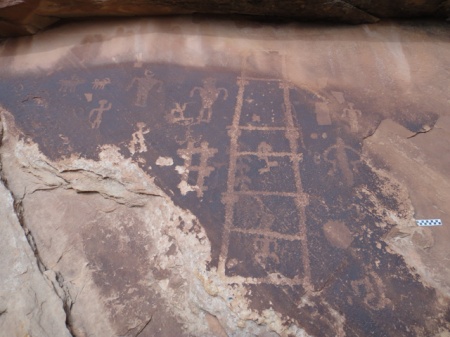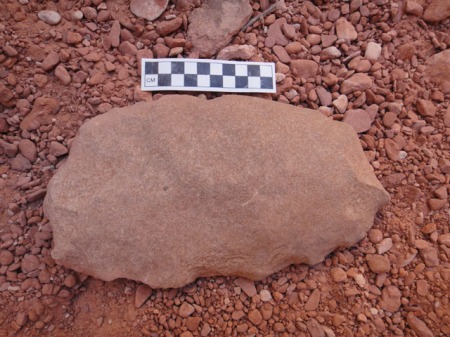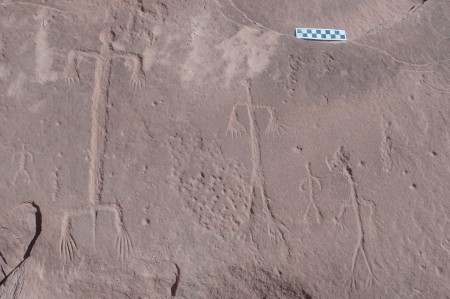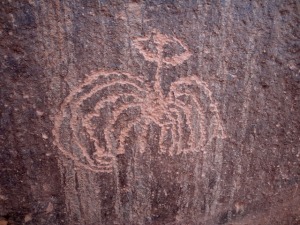We have just returned from another exciting Spring break trip to southeast Utah. We made the usual rounds, from Cisco down to Bluff and Mexican Hat, across Cedar Mesa, back up through Hanksville to Price, and on to Green River and Moab for a day. The weather was varied as it always is this time of year- from freezing cold and strong winds, to sunny, warm, summer-like days. You just never know what you’ll get in Spring in southeast Utah and it is important to be prepared for everything from sitting out snowstorms in the tent for a few days, to having plenty of sunblock and your shorts and river sandals on hand.
Comb Ridge
One of the highlights of our trip included five days of camping near the San Juan River outside Bluff, and hiking there and in Comb Ridge. We also hiked along the river, including a look at the panels around Sand Island, and up some small side canyons right from camp. But most of our time was spent in the middle part of Comb Ridge. We managed to see five of the canyons there with ruins and rock art around every corner. We did our best to hike up one canyon then down another, but as anyone who has been along Comb Ridge knows, there are plenty of pour offs to send you back the way you came or at least send you looking for another route. The good thing about Comb Ridge is that the canyons are all short, and backtracking is never a big deal. Comb Ridge was a busy place, with lots of hikers and people camping at nearly every site along Butler Wash. Keep this in mind if you plan a visit over Spring break.

A kiva in one of the Comb Ridge canyons.
Tracking Practice
We did take advantage of having to backtrack from a couple of the canyons, using it as a chance to work on our tracking skills and to see a different part of the lives of the ancient inhabitants along the canyon mouths- including ancient campsites, lithic scatters, and storage cysts. Some of the approaches were long for us (we didn’t drive to a different “trailhead” for each canyon, but worked our way along the ridge from one). The walks back along these routes allowed us to find our tracks coming in, examine them for changes based on the weather and other hikers, and follow them back to our start point. Again, being Spring break, there were plenty of other hikers out- because of this we were forced to use the lost track drill a number of times, casting about for our tracks among others, and doing the same out on the flat where we made it a point to use anti-tracking measures on our way in. By anti-tracking, or counter-tracking, I mean simply trying to walk as carefully as possible so as to hide our tracks- walking close to brush in shadows, through heavy, well-traveled brush, and across slickrock patches wherever we could. In doing so we benefited going out and coming back.

A grooved stone we found on our approach to one of the canyons. Grooves are on both sides, running parallel. Pictured side is the more pronounced. Scale is in centimeters.
The Dirty Devil River
After our stay in the Comb Ridge area we headed west and spent a night near Hite on the rim of the Dirty Devil River canyon. The river was flowing at about 150 CFS then, but the mud chutes at the end of the river and directly flowing into the Colorado at this point were not promising for a float. It looked like a muddy mess ready to capture anyone who stepped into it. The lake was so low that the Dirty Devil actually flowed into the Colorado River, and together they flowed off into the distance, a thin stream of a river in the middle of a vast horizon of mud.

Dirty Devil River as it flows toward the Colorado at Hite Crossing. A murky thread of water through dried mud.
We stopped for a day in the Irish Canyons in North Wash, and then spent a night at Angel Point and had a walk down to the Dirty Devil River the next day. The river looked much more floatable from this point, really looking like it was flowing at 150 CFS and without a sandbar snag in sight. We recently had some comments and questions on putting in there. Aside from the walk down to the river- across slickrock, rocky with exposure in a few places, and bushy in others, the river looked good. The party mentioned was using 5 pound pack rafts- we are still waiting to hear the outcome.
Nine Mile Canyon
Next was a visit to Price and the College of Eastern Utah Museum. The museum houses a collection of artifacts from the surrounding region highlighting, among other things, the Fremont culture. There is also an impressive paleontology collection. If you visit Price, or even find yourself driving through, the museum can be found right in the center of town and is worth the stop. From Price it is just a 15 minute drive south to Wellington and the turn off into Nine Mile Canyon.

A well known pictograph in Nine Mile Canyon. You may have seen this one featured in National Geographic. The damage happened long ago before the state intervened on behalf of the preservation of pre-history here.
The name of the canyon is deceiving, being some 70 miles long in total. The road through the canyon has been recently paved, and is in perfect shape. The is a short section mid-way that remains unpaved, but any vehicle can make it all the way up to the Big Buffalo and Great Hunt petroglyph panels, some of the highlights of the canyon. We turned around there and backtracked, but you can continue north from about mile 37 to Myton. In my opinion, the canyon has more than can be seen in a long day, especially if you plan to do any of the hikes-there are countless rock art site, ruins, and many points of historic interest. Note that camping is not allowed anywhere in the canyon, other than at the Nine Mile Ranch private campground. So plan accordingly and start your trip into the canyon early, allowing at least a full day.

One of the more well-known panels in Nine Mile Canyon- called the Great Hunt panel.
Gear Reviews
I always try to highlight a piece of gear in each blog, and for this post I have chosen Rite in the Rain notebooks and Fisher Pens. It is hard to imagine one without the other. Rite in the Rain notebooks come in many different sizes and page formats, but I tend to use one of the originals- the 3 by 5 inch, spiral top notebook. It fits easily into any pocket and with its plastic cover, it is virtually indestructible. But the key feature that makes Rite in the Rain products so important to someone who spends a lot of time outdoors is that the pages are waterproof. I have swam with my notebooks, used them in monsoon rains where I have been soaked through, taken notes during archaeological fieldwork sessions in dripping Central American jungles, and used them for years while in the military. I cannot say enough about the quality and functionality of their products. You can see the spiral bound notebooks and Fisher pens at TwoHandsPaperie.com.

Rite in the Rain spiral notebooks- a collection from over the years, including one of Nicolai’s. Archaeological fieldwork, river trips, bikepacking trips, and backpacks are all recorded here.
Fisher pens are the perfect companion writing instrument for the waterproof notebooks. Fisher pen refills are pressurized, and will write upside down, in any temperature you might normally encounter, and on wet Rite in the Rain notebook pages. The Stowaway Pen with a clip is the perfect pen for the 3 by 5 spiral top notebook- the pen slides right into the spiral and clips into place. This pen is also about the most lightweight pen imaginable. The only thing lighter might be just a pen refill by itself! The refills last an incredibly long time as well, and perform perfectly in the desert, mountains, or jungle.

Rite in the Rain 3 by 5 inch spiral notebook with Fisher Stowaway pen securely fastened in spiral binding.
For more on our desert adventures, tracking, and rock art, visit the Desert Explorer website.




 Posted by desertexplorer
Posted by desertexplorer 



































